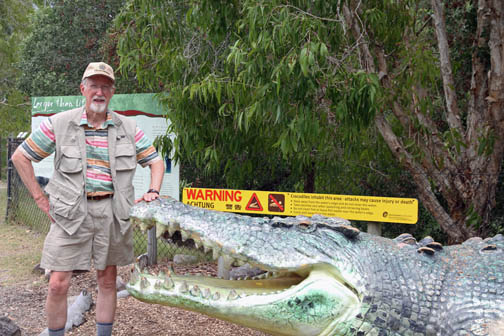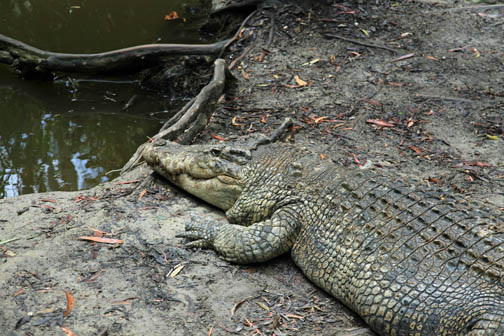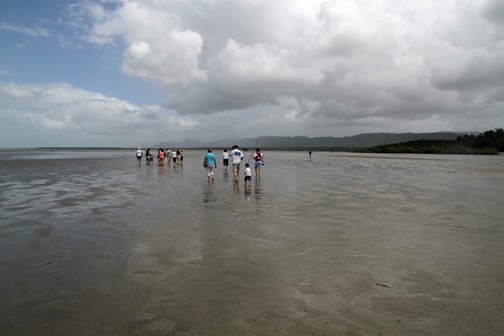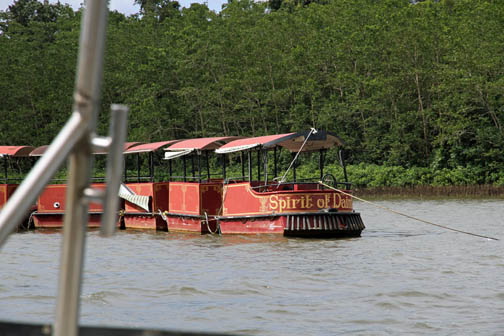Danger Down Under (2)
Fireside Talk: Danger Down Under (2)
Posted November 25, 2012
J. William T. Youngs
Something in us likes our National Parks to seem wild, even dangerous. That is why two of the more dramatic stories in the Ken Burns-Dayton Duncan miniseries on the parks feature life-threatening (or life-terminating) adventures. I’m thinking of Truman Everts in Yellowstone and of Bessie and Glen Hyde in the Grand Canyon. Everts left all but about 60 pounds of his body-weight behind him after being lost for thirty-nine days in Yellowstone, and the Hydes disappeared all together on the Colorado River. Of course, none of us would want to endure the fate of any of those three unfortunates, but their sacrifices underscores the fact that there are places in the America where the terrain is wild indeed.
Having returned from two weeks in Australia, I can report that the United States has not cornered the market on the cult of natural danger. In fact, in their parks and throughout the land as a whole, Australians love to brag about the dangers of their environment. On November 11, 2012, I found myself in a tour bus bound up the coast of the Coral Sea from Caines to Port Douglas in northern Queensland. We had not driven a kilometer before the driver had welcomed us to a country where “even the butterflies can kill you – and you’ll be dead in ten seconds!”
Then and there I learned that what I’m calling “danger Down Under” is as much fantasy as reality. Fantasy is definitely a part of the Australian danger culture; but then, so too is reality, as we shall see.
On the bragging level, we heard from other tour bus drivers that something like eight of the ten most deadly snakes in the world live in Australia; the giant cassowary bird can disembowel you with its claws; and the kangaroos can beat you to death with their feet. And the crocodiles.... Oh, the crocodiles. The Australians love to brag about the fierceness of their crocodiles. One driver was eager to tell us that our American alligators are mere pretenders in comparison to the Australian crocodiles. “We had alligators here once,” said the driver, “but our crocs ate them all.”
While in Queensland, I had a couple of chances to see crocodiles up close and personal. Here I am cozying up to a one -- or to be more honest, a statue of one:
Posted November 25, 2012
J. William T. Youngs
Something in us likes our National Parks to seem wild, even dangerous. That is why two of the more dramatic stories in the Ken Burns-Dayton Duncan miniseries on the parks feature life-threatening (or life-terminating) adventures. I’m thinking of Truman Everts in Yellowstone and of Bessie and Glen Hyde in the Grand Canyon. Everts left all but about 60 pounds of his body-weight behind him after being lost for thirty-nine days in Yellowstone, and the Hydes disappeared all together on the Colorado River. Of course, none of us would want to endure the fate of any of those three unfortunates, but their sacrifices underscores the fact that there are places in the America where the terrain is wild indeed.
Having returned from two weeks in Australia, I can report that the United States has not cornered the market on the cult of natural danger. In fact, in their parks and throughout the land as a whole, Australians love to brag about the dangers of their environment. On November 11, 2012, I found myself in a tour bus bound up the coast of the Coral Sea from Caines to Port Douglas in northern Queensland. We had not driven a kilometer before the driver had welcomed us to a country where “even the butterflies can kill you – and you’ll be dead in ten seconds!”
Then and there I learned that what I’m calling “danger Down Under” is as much fantasy as reality. Fantasy is definitely a part of the Australian danger culture; but then, so too is reality, as we shall see.
On the bragging level, we heard from other tour bus drivers that something like eight of the ten most deadly snakes in the world live in Australia; the giant cassowary bird can disembowel you with its claws; and the kangaroos can beat you to death with their feet. And the crocodiles.... Oh, the crocodiles. The Australians love to brag about the fierceness of their crocodiles. One driver was eager to tell us that our American alligators are mere pretenders in comparison to the Australian crocodiles. “We had alligators here once,” said the driver, “but our crocs ate them all.”
While in Queensland, I had a couple of chances to see crocodiles up close and personal. Here I am cozying up to a one -- or to be more honest, a statue of one:
This crocodile statue represents the biggest such creature ever encountered, about 25-feet long. That’s a lot bigger than the average croc, but 10 to 15 feet of a brute like this makes even a grizzly bear seem less than formidable. Here is one of many I saw in a crocodile park in Queensland:
At various times during my journey through Australia I heard other stories and saw other signs of dangerous animals. We couldn’t swim in the Coral Sea, near our hotel in Port Douglas, because of the danger of sea crocodiles and jelly fish. Beside the ocean at one beach is Sydney there is an artificial lake complete with a sand beach; the real ocean is too dangerous because of sharks. In the rain forest near Port Douglas you were warned to stay on the trail as the woods contained sharp vines that could completely entangle you; other trailside signs warned about the leaves of poisonous plants the touch of which is “extremely painful.”
Some of the danger stories were pure “hype,” but a lot were not. One of our tours was along the shore and among mangrove trees on the Coral Sea. Here we are with our aboriginal guide:
Some of the danger stories were pure “hype,” but a lot were not. One of our tours was along the shore and among mangrove trees on the Coral Sea. Here we are with our aboriginal guide:
Pointing offshore our guide explained to us that out there is where Steve Irwin died while trying to ride a stingray for an episode in his popular TV series “Crocodile Man.”
During the two short weeks I was in Australia, one man was killed from the venom of a deadly taipan snake, and a seven-year-old girl “went missing” – soon to be recovered from the belly of a crocodile.
One death-by-crocodile struck me as especially poignant. We were in a boat for an hours croc sighting tour on the Daintree River. In our seats we were well-protected by the high sides of the boat. Anchored downstream from our own boat dock was another sight-seeing rig consisting of several barges fitted out to look like a train. Here is what the “Spirit of Daintree” looks like:
During the two short weeks I was in Australia, one man was killed from the venom of a deadly taipan snake, and a seven-year-old girl “went missing” – soon to be recovered from the belly of a crocodile.
One death-by-crocodile struck me as especially poignant. We were in a boat for an hours croc sighting tour on the Daintree River. In our seats we were well-protected by the high sides of the boat. Anchored downstream from our own boat dock was another sight-seeing rig consisting of several barges fitted out to look like a train. Here is what the “Spirit of Daintree” looks like:
Our guide explained that the owner of the train had given up the business a few years back after his five-year-old son was eaten by a crocodile. Soon we learned more about the tragedy:
The river was running especially high at the time, right up to the back porch of the owner’s house. A dog, belonging to the boy, jumped or fell into the water and the boy jumbed in after him. In an instant a crocodile, who may have been waiting for the dog, grabbed the boy and carried him off.
Somehow seeing that abandoned train brought this tragedy closer to me than others I only encountered in the newspapers. I imagine that little boy, proud of his father and the crocodile-watching train. He probably road along with his dad sometimes and learned about the crocodiles.
After the death of the boy the father gave up his business, but curiously he urged the authorities not to kill the croc, but to it instead to a nature park where is could live out its natural life. Before the crocodile was carried away, it was anesthetized and the boy’s remains were removed rom its stomach for burial.
And yes, most of us at least pay lip-service to the wonder of wild places and to the Land Ethic that says that all of nature exists for its own sake and not for ours. But how many of us could lose a child to a wild creature without demanding vengeance on the brute?
The river was running especially high at the time, right up to the back porch of the owner’s house. A dog, belonging to the boy, jumped or fell into the water and the boy jumbed in after him. In an instant a crocodile, who may have been waiting for the dog, grabbed the boy and carried him off.
Somehow seeing that abandoned train brought this tragedy closer to me than others I only encountered in the newspapers. I imagine that little boy, proud of his father and the crocodile-watching train. He probably road along with his dad sometimes and learned about the crocodiles.
After the death of the boy the father gave up his business, but curiously he urged the authorities not to kill the croc, but to it instead to a nature park where is could live out its natural life. Before the crocodile was carried away, it was anesthetized and the boy’s remains were removed rom its stomach for burial.
And yes, most of us at least pay lip-service to the wonder of wild places and to the Land Ethic that says that all of nature exists for its own sake and not for ours. But how many of us could lose a child to a wild creature without demanding vengeance on the brute?




